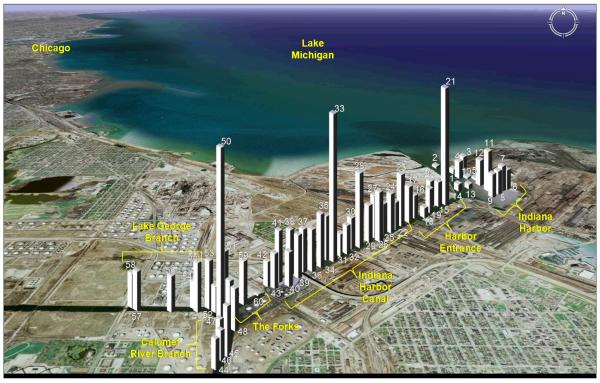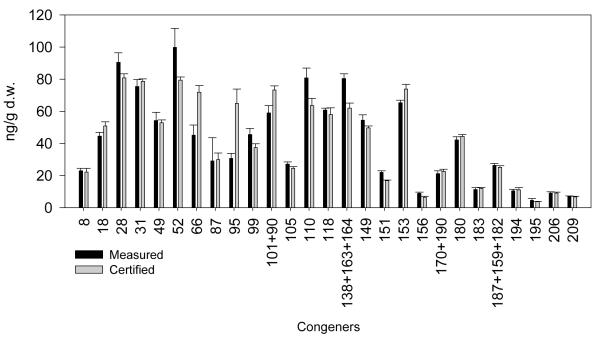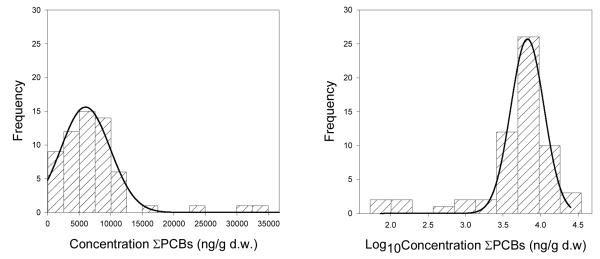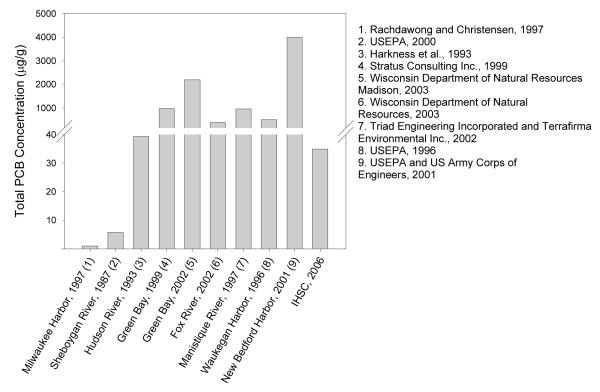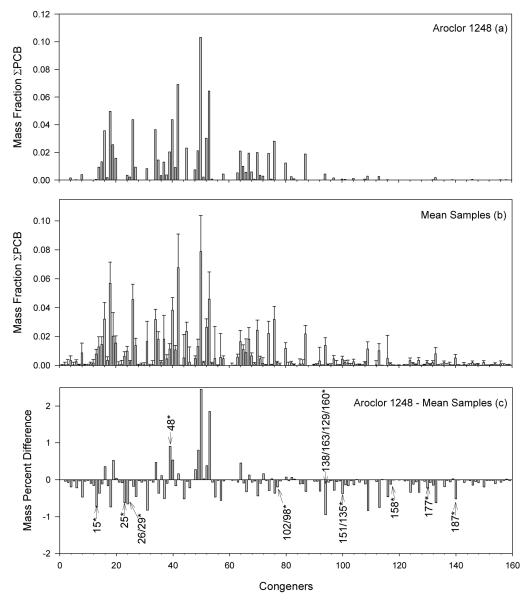Abstract
We report the results of the first intensive survey of polychlorinated biphenyls (PCBs) in the surficial sediment of the Indiana Harbor and Ship Canal (IHSC) in East Chicago, Indiana, a part of the Calumet River tributary of Lake Michigan that will be dredged to maintain depth for ship traffic. The tributary has previously been reported to be a large source of PCBs to Lake Michigan. PCB congeners were measured using tandem mass spectrometry in multiple reaction monitoring mode, a method that provides a high level selectivity and sensitivity for PCBs in complex environmental samples. The PCB concentrations (sum of 163 congeners or coeluting peaks) range from 53 to 35,000 ng g−1 d.w. and are comparable to other PCB concentrations at contaminated tributaries in the United States, most of them (although not IHSC) established by law as Superfund sites. The PCB congener signal strongly resembles the original technical mixture Aroclor 1248 that has experienced a small amount of weathering — less than 2.5% by mass for the statistically different congeners - consistent with desorption, volatilization, and microbial dechlorination. The origin of the PCBs in IHSC is not known but Aroclor 1248 was used in hydraulic fluids, vacuum pumps, plasticizers and adhesives. Possible uses of this mixture in East Chicago included the equipment and auxiliary services for the adjacent steel mill and gas refinery and/or lubrication for the drawbridges spanning the canal.
Keywords: Lake Michigan, Persistent Organic Pollutants (POPs), EPA method 1668a, congener profile and distribution, Aroclor 1248, PCB weathering
1. Introduction
East Chicago is a heavily industrialized urban community on the southern shore of Lake Michigan. Penetrating the city center is the Indiana Harbor and Ship Canal (IHSC). The construction of IHSC was authorized in 1913 to serve industries and provide a connection between Lake Michigan and the Grand Calumet River. The connection is no longer maintained for navigational purposes. The IHSC system is approximately 7 km long, with two branch canals (Lake George Branch and Grand Calumet River Branch). Currently, the main industries located in this area are Mittal Steel USA Inc, LTV Steel Company Inc, Safety Kleen Oil Recovery Co and BP Products North America Inc. The IHSC is an active canal system that continues to support large vessels. To remain viable for industrial shipping, the U. S. Army Corps of Engineers, Chicago District, is planning to begin a long-term dredging project in 2009 to restore adequate navigational depth. The sediment will be disposed in a Confined Disposal Facility (CDF), which is under construction, and will be located north of Lake George Branch, less than 100 meters from the canal (US Army Corps of Engineers, 2005b).
Due to years of heavy industrial operation, the area has been contaminated with heavy metals, polycyclic aromatic hydrocarbons (PAHs) and polychlorinated biphenyls (PCBs). As a result, the International Joint Commission designated the IHSC as an Area of Concern (International Joint Commission, 2003). The IHSC and Grand Calumet River has been shown to include regions that are toxic to invertebrates (Burton et al., 1996; Canfield et al., 1996; Ingersoll et al., 2002; Rathbun et al., 1996). Sediment collected from IHSC presents the highest toxicity in comparison to Buffalo and Saginaw rivers (Canfield et al., 1996; Rathbun et al., 1996), and are among the most contaminated and toxic Great Lakes sediments that have been evaluated (Ingersoll et al., 2002).
There is little published data of spatial extent and concentration magnitude of PCBs in the sediment in IHSC. The Army Corps report that PCBs were found in IHSC sediment since 1977 but has not published a full report (Pittman, personal communication). There is no data about methods of quantification of individual PCB congeners or quality control. Custer and coworkers report high levels of PCBs in tissue of lesser scaup (Aythya affinis), a diving duck dwelling in IHSC (Custer et al., 2000). Although not commonly used for food, the authors noted that the PCB concentration in 88% of the birds exceeded the PCB human consumption guidelines for edible poultry in USA (>3.0 μg g−1 lipid wt.) (FDA, 1979).
The U. S. Army Corps of Engineers have monitored airborne PCBs in the region since 2001 (US Army Corps of Engineers, 2005a). They have reported concentrations of PCB congeners that are comparable to concentrations measured in Chicago (a region of elevated airborne PCBs) and much higher than reported for remote and rural locations around Lake Michigan (Sun et al., 2007).
Due to the intense industrial activity in the area surrounding the IHSC during the time that PCBs were heavily used, we hypothesized that the IHSC surficial sediment would be heavily contaminated. We further hypothesized that the current congener distribution of PCBs in the surficial sediment continues to resemble the original commercial mixtures distributed by Monsanto Company in the middle part of the last century. Therefore, the central purpose of this study was to investigate the spatial extent and concentration magnitude of PCB congeners in surficial sediment from Indiana Harbor and Ship Canal, which presumably will be the first sediment layer to resuspend into the water column when dredging operations begin.
2. Methods
2.1 Sampling Method
During August 2006, 60 surficial sediments were sampled in IHSC, East Chicago, Indiana (Figure 1 and Table S1 in supporting information) from aboard the U.S. Environmental Protection Agency’s R/V Mudpuppy. A standard Ponar dredge sampler (clamshell-bucket) was used to collect the top 10 cm layer of surficial sediment. The sediment sample from each site was homogenized on the ship deck and divided into 3 precleaned amber jars, around 200 g each. Jars were completely filled and capped, avoiding any headspace. The samples were brought to The University of Iowa and kept refrigerated at 4° C until extraction and analysis.
Figure 1.
Spatial location and measured ΣPCB concentration (ng g−1 d. w.) in surficial sediment of IHSC. The height of the bars represents the total PCB concentration and the number over or next to each bar is the sample ID (see also Table S1 in the supporting information). The canals regions are U.S Army Corps of Engineers designations.
2.2 Analytical Method
The analytical method employed for sample extraction is a modification of U.S. EPA Method 3545 (Bandh et al., 2000; Bjorklund et al., 1999; Josefsson et al., 2006; USEPA, 1995a). Briefly, samples were weighed (~3 g) and mixed with a known amount of combusted diatomaceous earth and spiked with 500 ng surrogate standard, PCB14 (3,5-dichlorobiphenyl), PCB65 (2,3,5,6-tetrachlorobiphenyl) and PCB166 (2,3,4,4′,5,6-hexachlorobiphenyl) (Cambridge Isotope Laboratories, Inc.). The sediments were extracted utilizing a pressurized fluid extraction (Accelerated Solvent Extractor, Dionex ASE-300), of equal parts acetone and hexane. The sediment water content was determined gravimetrically for each sample from a separate aliquot by drying for 12 hrs at 104° C.
Polar interferences and other compounds were removed by extraction with KOH and then with sulfuric acid. The final hexane extract was passed through a Pasteur pipette filled with 0.1 g of combusted silica gel and 1 g of acidified silica gel (2:1 silica gel:acid by weight) (USEPA, 1995b) and eluted with hexane. PCB204 (2,2′,3,4,4′,5,6,6′-octachlorobiphenyl) was added as internal standard (100 ng; Cambridge Isotope Laboratories, Inc.).
PCB quantification was carried out employing a modification of EPA Method 1668a (USEPA, 1999). Tandem Mass Spectrometry GC/MS/MS (Quattro Micro™ GC, Micromass MS Technologies) in multiple reaction monitoring (MRM) mode was utilized to quantify all 209 congeners in 163 individual or coeluting congener peaks (Table S2 in the supporting information), of which PCB14, PCB65 and PCB166 are surrogate standards and PCB204 is internal standard. The gas chromatogram (GC) was equipped with a Supelco SBP-Octyl capillary column (30 m × 0.25 mm ID, 0.25 μm film thickness) with helium as carrier gas at a constant flow rate of 0.8 ml min−1. The GC operates at the following conditions: injector temperature 270° C, interface temperature 290° C, initial temperature 75° C, initial time 2 minutes. The GC temperature program is 75 to 150° C at 15° C min−1, 150 to 290° C at 2.5° C min−1, and final time 1 minute. Figure S1 in the supporting information includes a calibration chromatogram, as well as a sample chromatogram. Linearity of the instrument response was confirmed and PCB congener mass calculation was performed applying relative response factor (RRF) obtained from the calibration curve for each congener. Total organic carbon (TOC) was analyzed by Minnesota Valley Testing Laboratories. Inc (SW-846 Method SW 9060).
3. Results and Discussion
3.1 Quality Assurance and Control
Quality Assurance and Control (QA/QC) was rigorously assessed using surrogate PCB standards, blanks, replicates and standard reference material. Percentage recovery of surrogate standard PCB14 and PCB166 yielded a mean of 93% and 85%, and a median of 83% and 85%, respectively. Their standard deviations were 36% and 16%, and within a range of 49% – 191% for PCB 14, and 58%– 130% for PCB 166. Surrogate standard PCB65 yield high values due to coelution issues. PCB congener masses were corrected using the percentage recovery of congeners PCB14 (congeners 1 to 39) and PCB166 (congeners 40 to 209). Congener masses were not corrected for lab blanks, which were negligible. Table 1 depicts the results from 5 samples that were each extracted and analyzed multiple times. Sample 16 yielded an unusually high relative standard deviation (66%) that may indicate poor mixing in the sample jar. Standard Reference Material 1944, New York, New Jersey Waterway sediment (SRM 1944, National Institutes of Standards and Testing) was quantified. The analysis of SRM 1944 resulted in identification of all congeners, with an acceptable quantification results with respect to the certified values (Figure 2). The average percent difference between the measured and certified values (27 congeners) was 15 ± 15%. The congener masses were corrected as explained above.
Table 1.
Replicate results for 5 sediment samples, including number of replicates, mean, standard deviation and range in (ng g−1 d.w.), and relative standard deviation in percentage.
| Sample ID |
Number of replicates |
Mean (ng g−1 d.w.) |
Stdev (ng g−1 d.w.) |
Range (ng g−1 d.w.) |
RSD % |
|
|---|---|---|---|---|---|---|
| Min | Max | |||||
| 2 | 3 | 180 | 6 | 170 | 180 | 3% |
| 16 | 4 | 4,300 | 2,900 | 2,800 | 8,600 | 66% |
| 18 | 4 | 1,800 | 220 | 1,500 | 2,100 | 12% |
| 21 | 4 | 24,000 | 5,600 | 19,000 | 32,000 | 23% |
| 42 | 3 | 4,900 | 1,200 | 4,000 | 6,300 | 25% |
Figure 2.
Standard Reference Material® 1944 quantification results. The error bars represent one standard deviation above the arithmetic mean. The black bars represent the measured value obtained in the lab using our analytical method. The gray bars are the values certified by the National Institute of Standard & Technology.
3.2. Total PCB Concentration Analysis
The concentration of ΣPCBs (sum of all congeners, ng g−1 dry weight - d.w.) in the 60 samples ranges from 53 ng g−1 d.w. to 35,000 ng g−1 d.w. with an arithmetic mean 7,400 ng g−1 d.w. and a coefficient of variation of 90%. The geometric mean of the ΣPCB concentrations is 4,800 ng g−1 d.w., with a geometric standard deviation of 3.5 ng g−1 d.w. The total PCB concentration follows a log normal distribution (Figure 3). Total organic carbon content (TOC) in the sediments ranged from 0.43% to 7%, with an arithmetic mean of 4.6%, standard deviation of 1.5% and coefficient of variation of 32%. Neither linear nor logarithmic transformation correlations were strong between ΣPCB concentrations and % TOC (r2=0.23 and 0.49, respectively), indicating that equilibrium of PCBs with particulate organic carbon does not control or predict ΣPCB concentration in the sediment of IHSC. These results differ from an EPA study of Lake Michigan sediments (USEPA 2004), where logarithmic transformation showed a strong relationship between both variables. IHSC samples normalized to % TOC range from 2,800 to 680,000 (ngPCB g−1 TOC), with an arithmetic mean of 160,000 (ngPCB g−1 TOC) and a coefficient of variation of 80%.
Figure 3.
Histograms of surficial sediment. Left plot in ng g−1 d.w., and right plot transformed to common logarithms. The curve in the left plot shows the lognormal distribution, while the curve in the right plot shows the fitted normal distribution.
The ΣPCB concentration in IHSC surficial sediment is lowest in the harbor near Lake Michigan (Table 2). The difference in concentrations between the Indiana Harbor samples and the rest of the IHSC is statistically significant (95% confidence level using log-transformed data). The concentration of surficial sediment of southern Lake Michigan is approximately 30 ng g−1 d.w. (USEPA, 2004), lower than in any location sampled in the IHSC. The much greater concentrations in the IHSC relative to Lake Michigan suggest that the sediment from IHSC could be a source of PCBs to the lake. Indeed, the Lake Michigan Mass Balance Study reports a total net load of 29.86 kg yr−1 PCBs from Calumet River, passing through IHSC, to Lake Michigan (USEPA, 2006). Desorption and/or sediment transport from the IHSC may be the origin of those PCBs (Gong et al., 1998; Thibodeaux, 2005).
Table 2.
Sample number, mean and range of total concentration of PCBs (ng g−1 d. w.) for the sections of Indiana Harbor and Ship Canal, East Chicago, Indiana.
| Location | Number of samples |
Mean (ng g−1 d.w.) |
Range (ng g−1 d.w.) |
|
|---|---|---|---|---|
| Min | Max | |||
| Indiana Harbor | 14 | 2,800 | 53 | 8,000 |
| Harbor Entrance | 7 | 7,300 | 1,800 | 24,000 |
| Indiana Harbor Canal | 23 | 8,700 | 140 | 30,100 |
| Calumet River Branch | 5 | 7,200 | 5,200 | 10,300 |
| Lake George Branch | 5 | 7,500 | 5,400 | 10,000 |
| The Forks | 6 | 13,000 | 5,200 | 35,000 |
The maximum ΣPCBs in surficial sediment found in IHSC falls within the range of other well-known contaminated sites in USA (Figure 4). The concentrations are much higher than the Milwaukee Harbor (Rachdawong and Christensen, 1997) and Sheboygan River Inner Harbor (USEPA, 2000), similar to Hudson River (Harkness et al., 1993), but lower than the Fox River and lower Green Bay (Stratus Consulting Inc, 1999; Wisconsin Department of Natural Resources Madison, 2003), Little Lake Butte des Morts Reach (Wisconsin Department of Natural Resources, 2003), Manistique River (Triad Engineering Incorporated and Terrafirma Environmental Inc., 2002), Waukegan Harbor (USEPA, 1996) and New Bedford Harbor (USEPA and US Army Corps of Engineers, 2001). Most of these sites have been designated as Superfund Sites, which require that remediation actions be implemented. IHSC is not a Superfund Site and is not being dredged for environmental remediation.
Figure 4.
Comparison of total concentration of PCB in surficial sediment with nine different sites across the United States, including IHSC (this study).
3.3. Congener Profile Distribution Analysis
The PCB homolog and congener distributions in the IHSC are nearly uniform from site to site and resemble Aroclor 1248 (Figure 5) (the arithmetic mean and standard deviation for each congener are presented in Table S2, supporting information). We compared the congener distribution of Aroclor 1016 lot A2, 1242 mean of 3 lots, 1248 lot A3.5, 1248 lot G3.5, 1254 lot A4, 1254 lot G4 and 1260 mean of 3 lots, reported by Frame et al. (Frame et al., 1996), with the average congeners profile distribution of our samples. Both Aroclor 1248 lots yielded the best linear correlation (r2≥0.91). Aroclor 1248 (Accustandard Lot B4020171) was then analyzed by our analytical method and the resulting r2 with Aroclor 1248 was 0.94. Despite the strong relationship found, 53% of the congeners are statistically different (99% confidence level) from this commercial mixture. The following are the 10 most different, in order of difference: PCB48, PCB15, PCB158, PCB187, PCB102/98, PCB26/29, PCB25, PCB177, PCB151/135 and PCB138/163/129/160. However, the differences between the Aroclor and IHSC congeners are less than 2.5% by mass (Figure 5).
Figure 5.
Congener distributions in mass percentage for Aroclor 1248 (Lot B4020171) (a), mean congener distribution of the 60 sediment sites (b) and Aroclor 1248 minus mean samples (c). In the case of (b), each sample was normalized to its total concentration, and the error bars represents one standard deviation about mean. Congeners are ordered by IUPAC number and listed in full in Table S2 in the supporting information, including the values depicted in (b). The asterisk (*) indicates a difference at the 99% confidence level as described in the text.
It appears that the IHSC was originally contaminated with Aroclor 1248, and that the small differences that now exist are the result of chemical, physical and biological transformations (weathering) in the sediments. The last time the IHSC was dredged was in 1972 - thirty-four years before our expedition; the surficial sediments may have been at the water-sediment surface for many years. Over time the lower chlorinated congeners (e.g. PCB 48) have been lost to volatilization, desorption and/or aerobic microbial degradation (Maltseva et al., 1999), and the high chlorinated ones due to anaerobic microbial dechlorination (Quensen et al., 1990). The relative enrichment of the lower-chlorinated and ortho-substituted congeners (PCBs 25 and 26/29) is probably a result of anaerobic microbial dechlorination (Quensen et al., 1990).
4. Conclusions
Employing tandem mass spectrometry we have conclusively determined that IHSC surficial sediments are contaminated with PCBs. The PCB levels found here are comparable to other PCBs contaminated sites in USA, most of them (although not IHSC) established by law as Superfund Sites. The analytical method used also allowed us to determine the PCB congener profile distribution in the sediment. The origin of the PCBs is not known but strongly resembles the original technical mixture Aroclor 1248. This mixture was used in hydraulic fluids, vacuum pumps, plasticizers and adhesives (US Department of Health and Human Services, 2000). Possible uses of this mixture in East Chicago included the equipment and auxiliary services for the adjacent steel mill and gas refinery and/or lubrication for the drawbridges spanning the canal. Finally, the PCBs in the sediments have undergone a small amount of weathering compared to the original 1248. The current congener profiles provide evidence of desorption, volatilization, and microbial dechlorination.
Supplementary Material
Acknowledgement
This work was funded as part of the Iowa Superfund Basic Research Program, NIEHS Grant ES013661. We gratefully acknowledge the Great Lakes National Program Office of the U.S. EPA for the donation of the Mudpuppy and crew. We thank Tom Ledolter for help in planning the Indiana Harbor and Ship Canal campaign, Christoffer von Schwerin for his useful work at the laboratory, and David Wethington (U.S. Army Corps of Engineers, Chicago Office) for assistance in sampling sediment from IHSC.
Footnotes
Supporting Information Available
References
- Bandh C, Bjorklund E, Mathiasson L, Naf C, Zebuhr Y. Comparison of Accelerated Solvent Extraction and Soxhlet Extraction for the Determination of PCBs in Baltic Sea Sediments. Environ Sci Technol. 2000;34:4995–5000. [Google Scholar]
- Bjorklund E, Bowadt S, Nilsson T, Mathiasson L. Pressurized fluid extraction of polychlorinated biphenyls in solid environmental samples. J Chromatogr A. 1999;836:285–293. [Google Scholar]
- Burton GA, Ingersoll CG, Burnett LC, Henry M, Hinman ML, Klaine SJ, et al. A comparison of sediment toxicity test methods at three Great Lake Areas of Concern. J Great Lakes Res. 1996;22:495–511. [Google Scholar]
- Canfield TJ, Dwyer FJ, Fairchild JF, Haverland PS, Ingersoll CG, Kemble NE, et al. Assessing Contamination in Great Lakes Sediments Using Benthic Invertebrate Communities and the Sediment Quality Triad Approach. J Great Lakes Res. 1996;22:565–583. [Google Scholar]
- Custer TW, Custer CM, Hines RK, Sparks DW. Trace elements, organochlorines, polycyclic aromatic hydrocarbons, dioxins, and furans in lesser scaup wintering on the Indiana Harbor Canal. Environ Pollut. 2000;110:469–482. doi: 10.1016/s0269-7491(99)00315-2. [DOI] [PubMed] [Google Scholar]
- FDA Polychlorinated biphenyls (PCBs); reduction of tolerances. Federal Register. 1979;44:38330–38340. [Google Scholar]
- Frame GM, Cochran JW, Bøwadt SS. Complete PCB congener distributions for 17 aroclor mixtures determined by 3 HRGC systems optimized for comprehensive, quantitative, congener-specific analysis. J High Res Chromatogr. 1996;19:657–668. [Google Scholar]
- Gong Y, Depinto JV, Rhee GY, Xia L. Desorption rates of two PCB congeners from suspended sediments--I. experimental results. Water Res. 1998;32:2507–2517. [Google Scholar]
- Harkness MR, McDermott JB, Abramowicz DA, Salvo JJ, Flanagan WP, Stephens ML, et al. In Situ Stimulation of Aerobic PCB Biodegradation in Hudson River Sediments. Science. 1993;259:503–507. doi: 10.1126/science.8424172. [DOI] [PubMed] [Google Scholar]
- Ingersoll CG, MacDonald DD, Brumbaugh WG, Johnson BT, Kemble NE, Kunz JL, et al. Toxicity Assessment of Sediments from the Grand Calumet River and Indiana Harbor Canal in Northwestern Indiana, USA. Arch Environ Contam Toxicol. 2002;43:156–167. doi: 10.1007/s00244-001-0051-0. [DOI] [PubMed] [Google Scholar]
- International Joint Commission . Status of Restoration Activities in Great Lakes Areas of Concern: A Special Report. 2003. Final. [Google Scholar]
- Josefsson S, Westbom R, Mathiasson L, Bjorklund E. Evaluation of PLE exhaustiveness for the extraction of PCBs from sediments and the influence of sediment characteristics. Anal Chim Acta. 2006;560:94–102. [Google Scholar]
- Maltseva OV, Tsoi TV, Quensen JF, Fukuda M, Tiedje JM. Degradation of anaerobic reductive dechlorination products of Aroclor 1242 by four aerobic bacteria. Biodegradation. 1999;10:363–371. doi: 10.1023/a:1008319306757. [DOI] [PubMed] [Google Scholar]
- Quensen JF, III, Boyd SA, Tiedje JM. Dechlorination of Four Commercial Polychlorinated Biphenyl Mixtures (Aroclors) by Anaerobic Microorganisms from Sediments. Appl Environ Microbiol. 1990;56:2360–2369. doi: 10.1128/aem.56.8.2360-2369.1990. [DOI] [PMC free article] [PubMed] [Google Scholar]
- Rachdawong P, Christensen ER. Determination of PCB Sources by a Principal Component Method with Nonnegative Constraints. Environ Sci Technol. 1997;31:2686–2691. [Google Scholar]
- Rathbun JE, Huellmantel LL, Tracy M, Smith VE, Ahlgren K. Rapid Sediment Assessment: Indicator Analysis and Screening Analysis Approaches. J Great Lakes Res. 1996;22:523–533. [Google Scholar]
- Stratus Consulting Inc . Final Report. 1999. PCB Pathway Determination for the Lower Fox River/Green Bay Natural Resource Damage Assessment. [Google Scholar]
- Sun P, Basu I, Blanchard P, Brice KA, Hites RA. Temporal and Spatial Trends of Atmospheric Polychlorinated Biphenyl Concentrations near the Great Lakes. Environ Sci Technol. 2007;41:1131–1136. doi: 10.1021/es061116j. [DOI] [PubMed] [Google Scholar]
- Thibodeaux LJ. Recent advances in our understanding of sediment-to-water contaminant fluxes: The soluble release fraction. Aquat Ecosyst Health Manage. 2005;8:1–9. [Google Scholar]
- Triad Engineering Incorporated and Terrafirma Environmental Inc . Remedial Action Plan Update Manistique River and Harbor. Area of Concern. Manistique, Michigan: 2002. [Google Scholar]
- US Army Corps of Engineers . In: Indiana Harbor and Canal Ambient Air Monitoring Program: Construction Phase Annual Report 2004. District C, editor. 2005a. [Google Scholar]
- US Army Corps of Engineers . Justification of Estimates for Civil Function Activities Department of the Army, Fiscal Year 2006. In: Great Lakes and Ohio River Division, editor. Congressional submission fiscal year 2006. 2005b. [Google Scholar]
- US Department of Health and Human Services Toxicological Profile for Polychlorinated Biphenyls (PCBs): Agency for Toxic Substances and Disease Registry. 2000 [PubMed] [Google Scholar]
- USEPA . Pressurized Fluid Extraction. Test Methods for Evaluating Solid Waste. 3rd ed. 1995a. Method 3545. update III. [Google Scholar]
- USEPA . Silica Gel Cleanup. Test Methods for Evaluating Solid Waste. 3rd ed. 1995b. Method 3630c. update III. [Google Scholar]
- USEPA . Evaluation of the Toxicity and Bioaccumulation of Contaminants in Sediments from Waukegan Harbor. Illinois: 1996. [Google Scholar]
- USEPA . Method 1668, Revision A: Chlorinated Biphenyl Congeners in Water, Soil, Sediment, and Tissue by HRGC/HRMS. 1999. [Google Scholar]
- USEPA . Superfund Record of Decision Sheboygan River and Harbor Sheboygan. Wisconsin: 2000. [Google Scholar]
- USEPA . Results of the Lake Michigan Mass Balance Study: Polychlorinated Biphenyls and trans-Nonachlor Data Report. 2004. [DOI] [PubMed] [Google Scholar]
- USEPA . Results of the Lake Michigan Mass Balance Project: Polychlorinated Biphenyls Modeling Report. 2006. [Google Scholar]
- USEPA. US Army Corps of Engineers . Inferred PCB Levels — 0 to 12 inch depth. New England District; 2001. New Bedford Harbor. [Google Scholar]
- Wisconsin Department of Natural Resources . Record of Decision Operable Units 3, 4, and 5 Lower Fox River and Green Bay, Wisconsin Record of Decision Responsiveness Summary. 2003. [Google Scholar]
- Wisconsin Department of Natural Resources Madison . Feasibility Study for the Lower Fox River and Green Bay, Wisconsin, Proposed Remedial Action Plan for the Lower Fox River and Green Bay, and Record of Decision for Operable Unit 1 and Operable Unit 2. 2003. White Paper NO. 19 — Estimates of PCB Mass, Sediment Volume, and Surface Sediment Concentrations in Operable Unit 5, Green Bay Using an Alternative Approach. Response to Comments on the Remedial Investigation for the Lower Fox River and Green Bay, Wisconsin. [Google Scholar]
Associated Data
This section collects any data citations, data availability statements, or supplementary materials included in this article.



